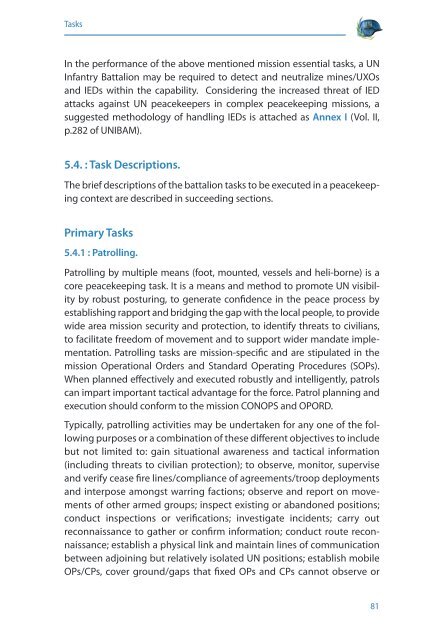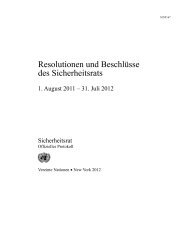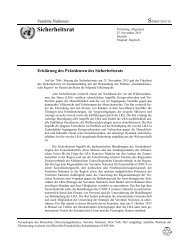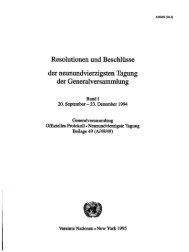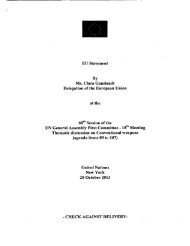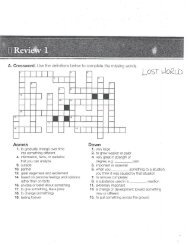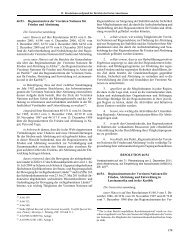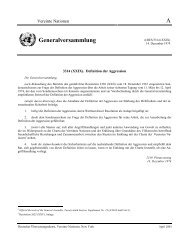United Nations Infantry Battalion Manual - the United Nations
United Nations Infantry Battalion Manual - the United Nations
United Nations Infantry Battalion Manual - the United Nations
Create successful ePaper yourself
Turn your PDF publications into a flip-book with our unique Google optimized e-Paper software.
tasks<br />
In <strong>the</strong> performance of <strong>the</strong> above mentioned mission essential tasks, a UN<br />
<strong>Infantry</strong> <strong>Battalion</strong> may be required to detect and neutralize mines/UXOs<br />
and IEDs within <strong>the</strong> capability. Considering <strong>the</strong> increased threat of IED<br />
attacks against UN peacekeepers in complex peacekeeping missions, a<br />
suggested methodology of handling IEDs is attached as Annex I (Vol. II,<br />
p.282 of UNIBAM).<br />
5.4. : Task Descriptions.<br />
The brief descriptions of <strong>the</strong> battalion tasks to be executed in a peacekeeping<br />
context are described in succeeding sections.<br />
Primary Tasks<br />
5.4.1 : Patrolling.<br />
Patrolling by multiple means (foot, mounted, vessels and heli-borne) is a<br />
core peacekeeping task. It is a means and method to promote UN visibility<br />
by robust posturing, to generate confidence in <strong>the</strong> peace process by<br />
establishing rapport and bridging <strong>the</strong> gap with <strong>the</strong> local people, to provide<br />
wide area mission security and protection, to identify threats to civilians,<br />
to facilitate freedom of movement and to support wider mandate implementation.<br />
Patrolling tasks are mission-specific and are stipulated in <strong>the</strong><br />
mission Operational Orders and Stand ard Operating Procedures (SOPs).<br />
When planned effectively and executed robustly and intelligently, patrols<br />
can impart important tactical advantage for <strong>the</strong> force. Patrol planning and<br />
execution should conform to <strong>the</strong> mission CONOPS and OPORD.<br />
Typically, patrolling activities may be undertaken for any one of <strong>the</strong> following<br />
purposes or a combination of <strong>the</strong>se different objectives to include<br />
but not limited to: gain situational awareness and tactical information<br />
(including threats to civilian protection); to observe, monitor, supervise<br />
and verify cease fire lines/compliance of agreements/troop deployments<br />
and interpose amongst warring factions; observe and report on movements<br />
of o<strong>the</strong>r armed groups; inspect existing or abandoned positions;<br />
conduct inspections or verifications; investigate incidents; carry out<br />
reconnaissance to ga<strong>the</strong>r or confirm information; conduct route reconnaissance;<br />
establish a physical link and maintain lines of communication<br />
between adjoining but relatively isolated UN positions; establish mobile<br />
OPs/CPs, cover ground/gaps that fixed OPs and CPs cannot observe or<br />
81


